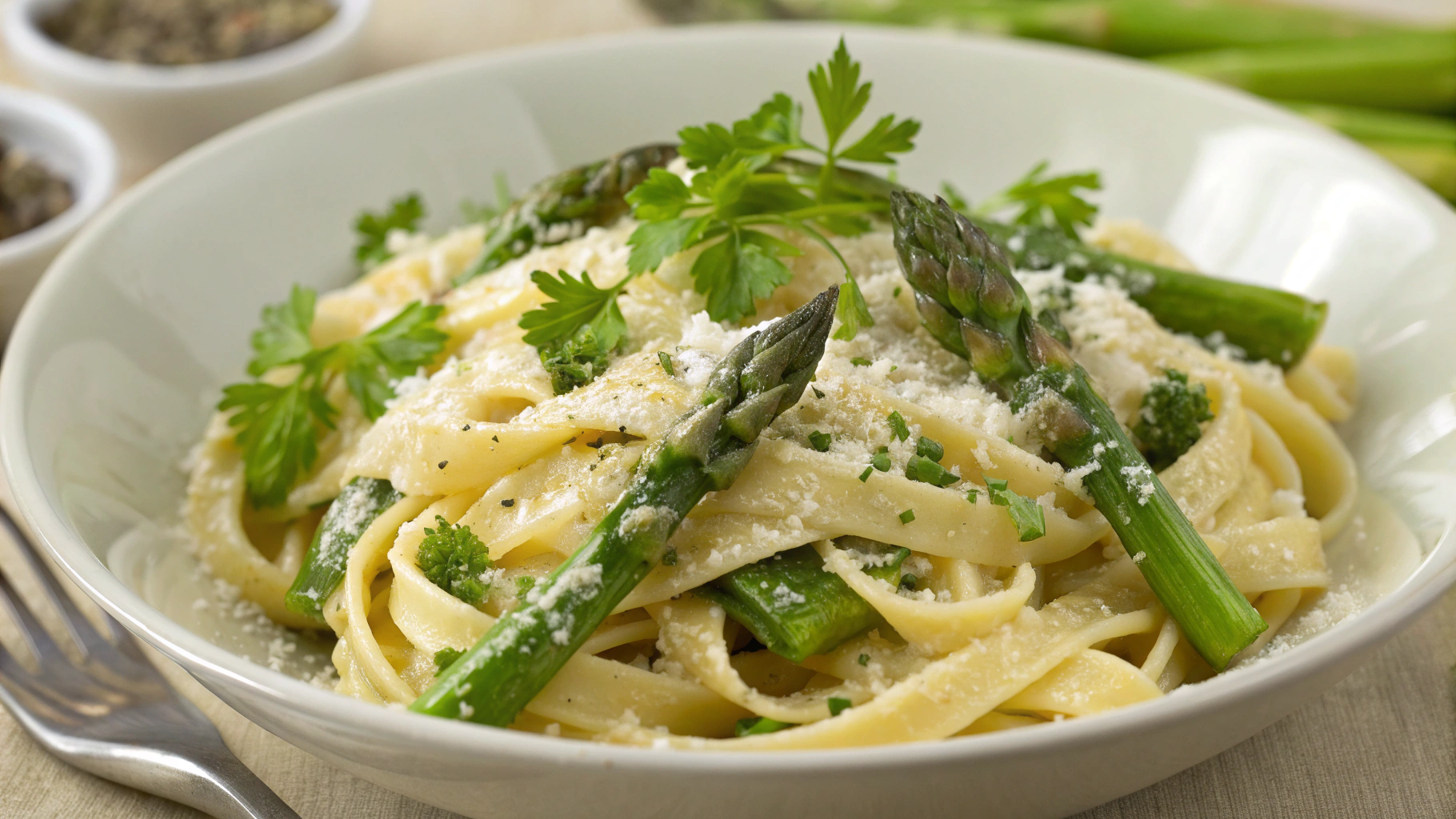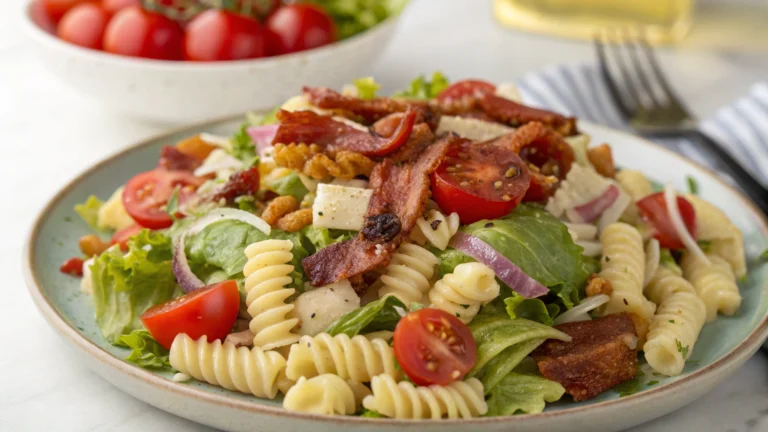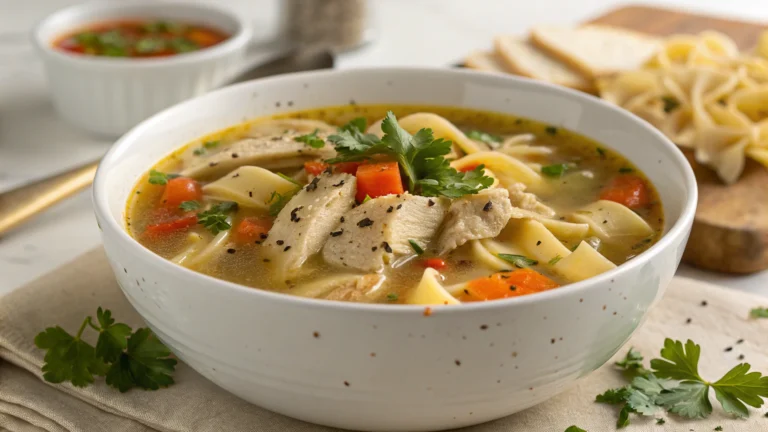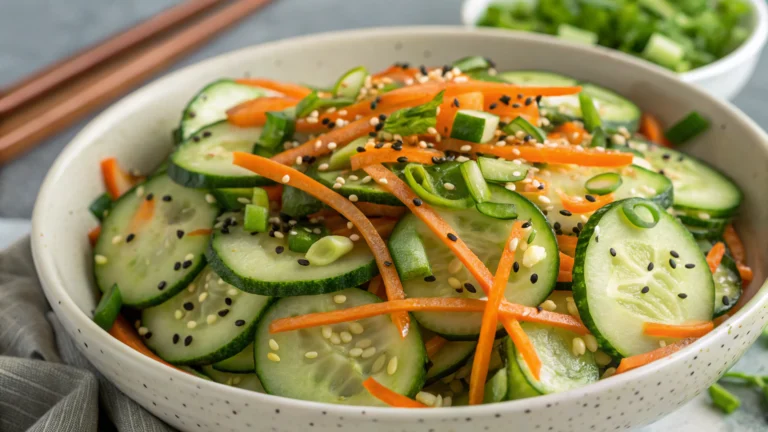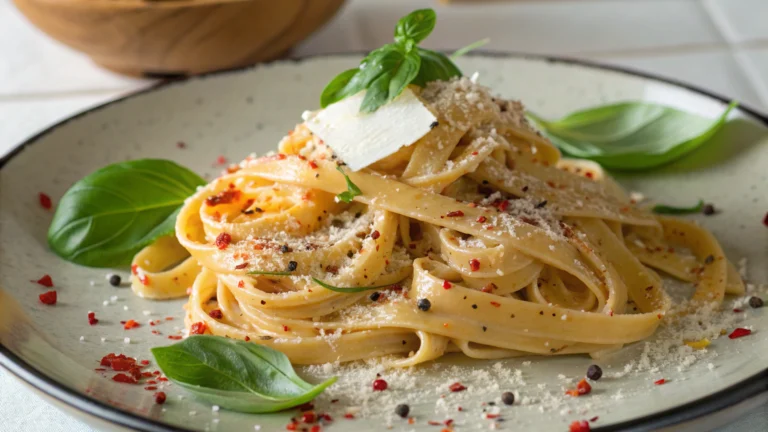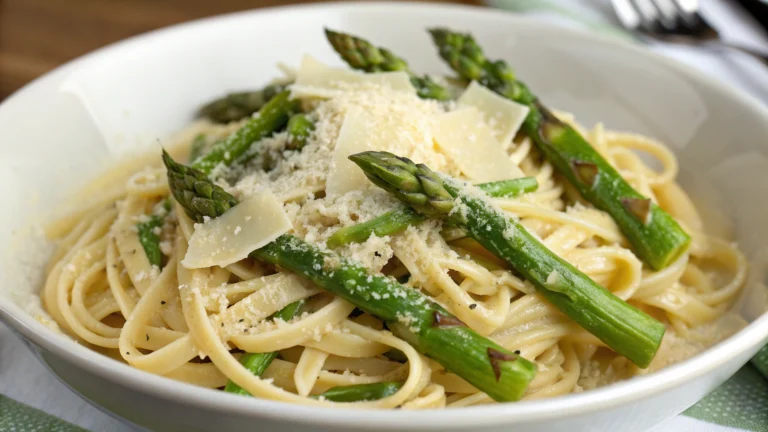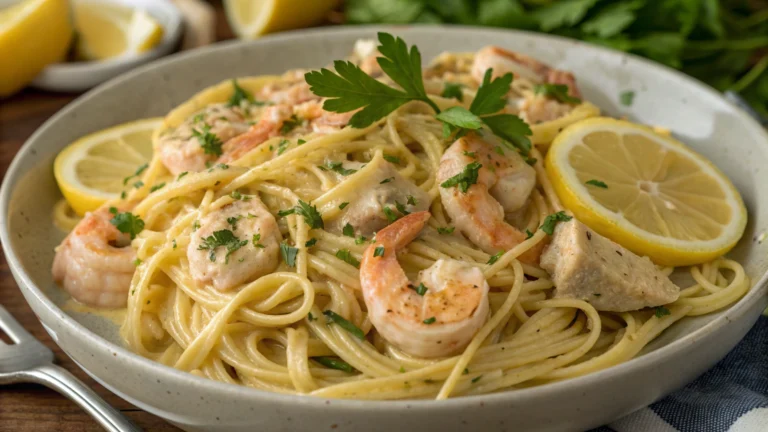Creamy Asparagus Pasta That Tastes Like Spring in 20
Forget fancy reservations. This bowl hits harder than a chef’s special and costs less than your latte habit.
Silky, garlicky sauce hugs tender pasta while asparagus brings snap and swagger. It’s weeknight-easy, date-night-pretty, and meal-prep-friendly.
One pan, big flavor, zero regrets. Ready to make your kitchen smell like victory?
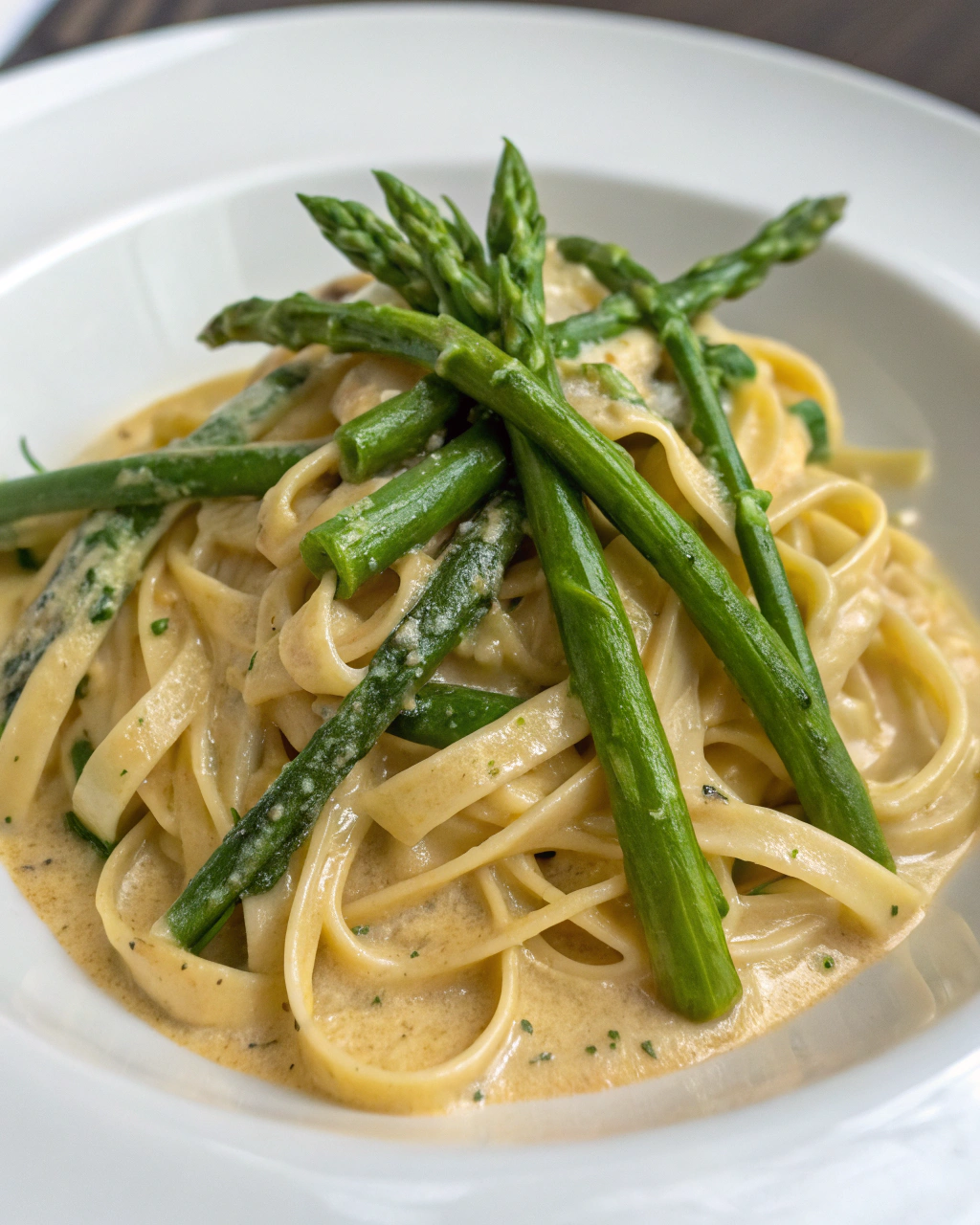
Why You’ll Love This Recipe
- Restaurant-level creaminess: The sauce is lush without feeling heavy, thanks to a clever blend of cream, pasta water, and Parmesan.
- Asparagus at its peak: Tender-crisp spears bring color, crunch, and legit freshness to balance the richness.
- 20–25 minutes total: You’ll be plating before a show intro finishes.
Minimal chopping, zero weird techniques.
- Flexible by design: Add chicken, shrimp, peas, lemon zest—this is an easy canvas for your cravings.
- Family- and crowd-friendly: It’s creamy comfort with enough greens to look virtuous. Win-win.
Servings, Prep, Cook, Calories
- Servings: 4
- Prep Time: 10 minutes
- Cook Time: 15 minutes
- Calories: ~520 per serving (estimate)
Ingredients Breakdown
- Pasta: 12 oz fettuccine, linguine, or rigatoni.
Long strands = silky; short shapes = catch-all sauce traps.
- Asparagus: 1 lb, ends trimmed, cut into 1–2 inch pieces. Thin spears cook faster; thick ones need an extra minute.
- Olive oil: 2 tbsp for sautéing and flavor.
- Butter: 2 tbsp for richness and gloss.
- Garlic: 3–4 cloves, minced.
The backbone of the sauce.
- Shallot: 1 small, finely diced (or 1/4 red onion). Adds sweet-savory depth.
- Heavy cream: 1 cup.
For that luxurious body.
- Pasta cooking water: 1–1.5 cups reserved. Liquid gold for emulsifying.
- Parmesan: 3/4 cup finely grated, plus more to finish.
Freshly grated melts better, FYI.
- Lemon: Zest of 1, juice of 1/2. Brightens everything like a spotlight.
- Fresh herbs: 2 tbsp chopped parsley or chives.
Optional but lovely.
- Red pepper flakes: 1/2 tsp (optional) for a gentle kick.
- Salt and black pepper: To taste. Season in layers for best results.
From Start to Finish
- Boil water. Salt it aggressively (like the sea).
Drop in pasta and cook until just shy of al dente. Reserve 1–1.5 cups pasta water before draining.
- Blanch or pan-cook asparagus. Option A: Toss asparagus into the pasta pot for the last 2–3 minutes.
Option B: Sauté in your sauce pan with 1 tbsp olive oil until bright green and crisp-tender. Set aside.
- Build aromatics. In a large skillet, warm remaining olive oil and butter over medium heat.
Add shallot and a pinch of salt; cook 2–3 minutes until soft. Stir in garlic and red pepper flakes; cook 30–60 seconds until fragrant (no burning—garlic drama is not invited).
- Create the base. Pour in cream and 1/2 cup pasta water.
Simmer gently 2–3 minutes to thicken slightly. Season with salt and pepper.
- Emulsify. Add drained pasta and asparagus to the skillet.
Toss over low heat, sprinkling in Parmesan gradually. Add more pasta water as needed to keep things glossy and fluid.
Aim for nappe-level cling, not soup.
- Brighten. Stir in lemon zest and juice. Taste, then adjust salt, pepper, and heat level.
If sauce tightens, loosen with another splash of pasta water.
- Finish. Off heat, fold in herbs. Plate with extra Parmesan, black pepper, and a drizzle of good olive oil.
If you feel fancy, add shaved Parm on top. Serve immediately.
How Long Does It Keep?
Fridge: 3 days in an airtight container.
The sauce will thicken; add a splash of water or milk when reheating. Microwave gently or warm on the stovetop over low heat.
Freezer: Not ideal.
Cream sauces can split when frozen. If you must, undercook pasta slightly and expect texture changes on thaw.
What’s Great About This
- Balanced richness: Cream + lemon + asparagus keeps it indulgent but not heavy.
- Reheats like a champ: A quick splash of liquid and it’s back to glossy goodness.
- Season-proof: Works with spring asparagus, but frozen peas or broccoli make it a year-round hero.
- Beginner-friendly: The technique teaches you restaurant-style emulsification—no culinary school required, IMO.
Nutrition Stats
- Calories: ~520 per serving
- Protein: ~18–20g (Parmesan and pasta contribute more than you’d think)
- Carbs: ~60–65g
- Fat: ~22–26g (mostly from cream, butter, and olive oil)
- Fiber: ~5–7g (thanks, asparagus + pasta)
- Sodium: Varies based on salting; go easy if using salty Parm and heavily salted water.
For lighter macros, use half-and-half or evaporated milk, and reduce butter to 1 tbsp.
For higher protein, add grilled chicken, shrimp, or white beans.
Watch Out for These Traps
- Broken sauce: High heat + cheese = clumps. Keep it low and add Parmesan gradually while tossing.
- Underseasoning: Cream dulls flavors.
Salt each layer—pasta water, sauce, final taste check.
- Mushy asparagus: It should bend, not flop. Cook until just tender and bright.
- Dry pasta: If it looks tight, add pasta water.
If it looks soupy, simmer 30 seconds more while tossing.
- Pre-shredded cheese: Anti-caking agents fight meltiness. Freshly grate for the silkiest results.
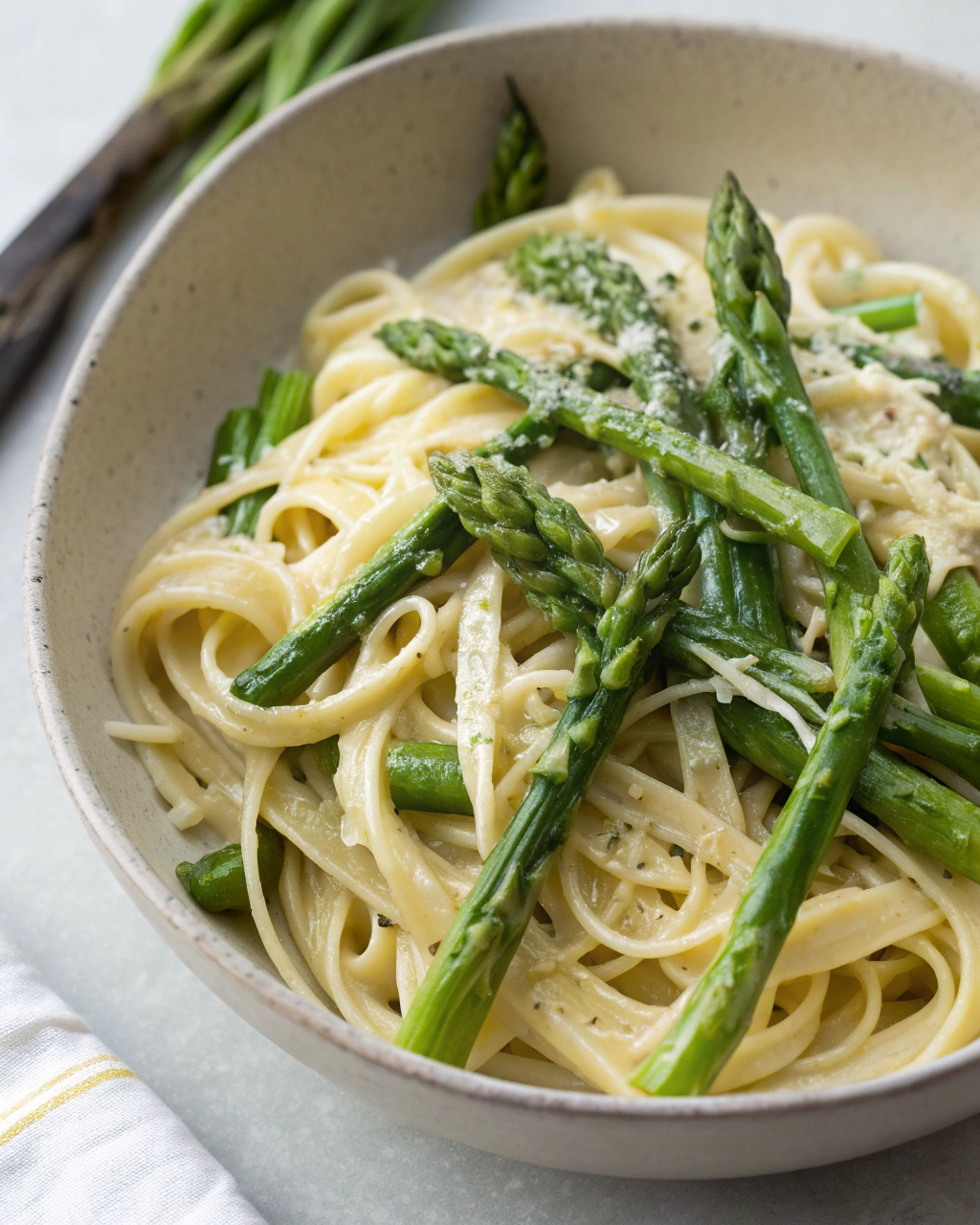
Different Takes
- Lemon-Pepper Burst: Add extra zest and cracked pepper, finish with a squeeze of lemon over each bowl.
- Spring Medley: Toss in peas, spinach, or sautéed mushrooms for more veg volume.
- Protein Boost: Pan-seared shrimp, grilled chicken, or crispy pancetta play beautifully here.
- Herb Garden Vibes: Swap parsley for tarragon or basil.
Chives add clean oniony lift.
- Lighter Cream: Use 3/4 cup half-and-half, thicken with a spoon of cream cheese or a knob of mascarpone.
- Gluten-Free: Use GF pasta and watch timings closely—reserve extra pasta water for insurance.
- Vegan-ish: Use olive oil + plant cream, nutritional yeast or vegan Parm, and add toasted pine nuts for richness.
FAQ
Can I use milk instead of cream?
Yes, but stabilize it. Use whole milk and add 2–3 tbsp cream cheese or a small knob of butter to prevent a thin, sad sauce.
Keep heat low to avoid curdling.
Do I have to blanch the asparagus?
No. Sautéing in the pan works great and adds a little caramelization.
Just don’t overcook—aim for bright green with slight bite.
Which pasta shape is best?
Fettuccine or linguine for silky slurpiness; rigatoni or penne if you like sauce pockets. Use what you love; the sauce isn’t picky.
Can I make it ahead?
You can cook the components ahead, but for peak texture, assemble right before serving.
If reheating, loosen with water or milk and warm gently.
How do I keep the sauce from clumping with the cheese?
Heat low, add cheese off heat or over the lowest flame, and toss vigorously with splashes of pasta water. Freshly grated Parm melts cleaner than the bagged stuff.
What wines pair well?
A crisp Sauvignon Blanc, Pinot Grigio, or a lightly oaked Chardonnay cuts through the cream and complements the asparagus beautifully.
My Take
This dish is the definition of high ROI: a handful of pantry basics, one seasonal star, and technique that makes you look dangerously competent.
The lemon zest is non-negotiable for me—it flips the richness from heavy to addictive. I like a hit of red pepper flakes for contrast and a rain of Parmesan because, well, joy.
Make it once, and watch it become your “I’ve got this” weeknight flex.

